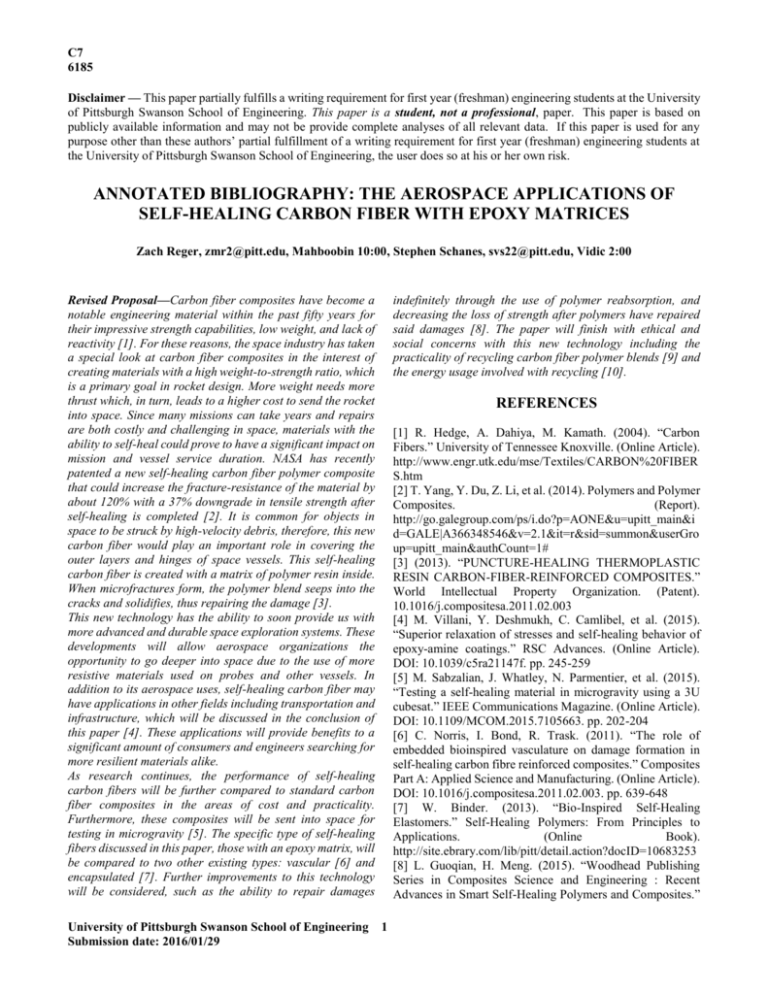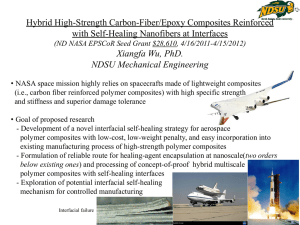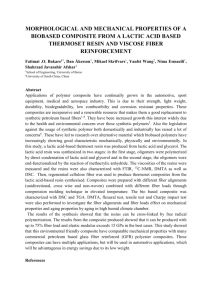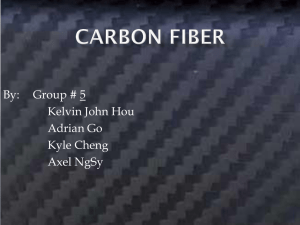This paper fits well into the composite fiber materials topic area
advertisement

C7 6185 Disclaimer — This paper partially fulfills a writing requirement for first year (freshman) engineering students at the University of Pittsburgh Swanson School of Engineering. This paper is a student, not a professional, paper. This paper is based on publicly available information and may not be provide complete analyses of all relevant data. If this paper is used for any purpose other than these authors’ partial fulfillment of a writing requirement for first year (freshman) engineering students at the University of Pittsburgh Swanson School of Engineering, the user does so at his or her own risk. ANNOTATED BIBLIOGRAPHY: THE AEROSPACE APPLICATIONS OF SELF-HEALING CARBON FIBER WITH EPOXY MATRICES Zach Reger, zmr2@pitt.edu, Mahboobin 10:00, Stephen Schanes, svs22@pitt.edu, Vidic 2:00 Revised Proposal—Carbon fiber composites have become a notable engineering material within the past fifty years for their impressive strength capabilities, low weight, and lack of reactivity [1]. For these reasons, the space industry has taken a special look at carbon fiber composites in the interest of creating materials with a high weight-to-strength ratio, which is a primary goal in rocket design. More weight needs more thrust which, in turn, leads to a higher cost to send the rocket into space. Since many missions can take years and repairs are both costly and challenging in space, materials with the ability to self-heal could prove to have a significant impact on mission and vessel service duration. NASA has recently patented a new self-healing carbon fiber polymer composite that could increase the fracture-resistance of the material by about 120% with a 37% downgrade in tensile strength after self-healing is completed [2]. It is common for objects in space to be struck by high-velocity debris, therefore, this new carbon fiber would play an important role in covering the outer layers and hinges of space vessels. This self-healing carbon fiber is created with a matrix of polymer resin inside. When microfractures form, the polymer blend seeps into the cracks and solidifies, thus repairing the damage [3]. This new technology has the ability to soon provide us with more advanced and durable space exploration systems. These developments will allow aerospace organizations the opportunity to go deeper into space due to the use of more resistive materials used on probes and other vessels. In addition to its aerospace uses, self-healing carbon fiber may have applications in other fields including transportation and infrastructure, which will be discussed in the conclusion of this paper [4]. These applications will provide benefits to a significant amount of consumers and engineers searching for more resilient materials alike. As research continues, the performance of self-healing carbon fibers will be further compared to standard carbon fiber composites in the areas of cost and practicality. Furthermore, these composites will be sent into space for testing in microgravity [5]. The specific type of self-healing fibers discussed in this paper, those with an epoxy matrix, will be compared to two other existing types: vascular [6] and encapsulated [7]. Further improvements to this technology will be considered, such as the ability to repair damages University of Pittsburgh Swanson School of Engineering Submission date: 2016/01/29 indefinitely through the use of polymer reabsorption, and decreasing the loss of strength after polymers have repaired said damages [8]. The paper will finish with ethical and social concerns with this new technology including the practicality of recycling carbon fiber polymer blends [9] and the energy usage involved with recycling [10]. REFERENCES [1] R. Hedge, A. Dahiya, M. Kamath. (2004). “Carbon Fibers.” University of Tennessee Knoxville. (Online Article). http://www.engr.utk.edu/mse/Textiles/CARBON%20FIBER S.htm [2] T. Yang, Y. Du, Z. Li, et al. (2014). Polymers and Polymer Composites. (Report). http://go.galegroup.com/ps/i.do?p=AONE&u=upitt_main&i d=GALE|A366348546&v=2.1&it=r&sid=summon&userGro up=upitt_main&authCount=1# [3] (2013). “PUNCTURE-HEALING THERMOPLASTIC RESIN CARBON-FIBER-REINFORCED COMPOSITES.” World Intellectual Property Organization. (Patent). 10.1016/j.compositesa.2011.02.003 [4] M. Villani, Y. Deshmukh, C. Camlibel, et al. (2015). “Superior relaxation of stresses and self-healing behavior of epoxy-amine coatings.” RSC Advances. (Online Article). DOI: 10.1039/c5ra21147f. pp. 245-259 [5] M. Sabzalian, J. Whatley, N. Parmentier, et al. (2015). “Testing a self-healing material in microgravity using a 3U cubesat.” IEEE Communications Magazine. (Online Article). DOI: 10.1109/MCOM.2015.7105663. pp. 202-204 [6] C. Norris, I. Bond, R. Trask. (2011). “The role of embedded bioinspired vasculature on damage formation in self-healing carbon fibre reinforced composites.” Composites Part A: Applied Science and Manufacturing. (Online Article). DOI: 10.1016/j.compositesa.2011.02.003. pp. 639-648 [7] W. Binder. (2013). “Bio-Inspired Self-Healing Elastomers.” Self-Healing Polymers: From Principles to Applications. (Online Book). http://site.ebrary.com/lib/pitt/detail.action?docID=10683253 [8] L. Guoqian, H. Meng. (2015). “Woodhead Publishing Series in Composites Science and Engineering : Recent Advances in Smart Self-Healing Polymers and Composites.” 1 Zachary Reger Stephen Schanes Elsevier Science. (Online Book). http://site.ebrary.com/lib/pitt/detail.action?docID=11062005 [9] P. Bajpai. (2013). “Update on Carbon Fiber.” Smithers Group. (Online Book). http://site.ebrary.com/lib/pitt/reader.action?docID=10717792 &ppg=62 [10]Y. Liu, A. Tiwari. (2015). “An Investigation into Minimising Total Energy Consumption and Total Completion Time in a Flexible Job Shop for Recycling Carbon Fiber Reinforced Polymer.” The 22nd CIRP Conference on Life Cycle Engineering. (Online Article). http://rt4rf9qn2y.search.serialssolutions.com/?ctx_ver=Z39. 88-2004&ctx_enc=info%3Aofi%2Fenc%3AUTF8&rfr_id=info:sid/summon.serialssolutions.com&rft_val_fm t=info:ofi/fmt:kev:mtx:journal&rft.genre=article&rft.atitle= An+investigation+into+minimising+total+energy+consumpt ion+and+total+completion+time+in+a+flexible+job+shop+f or+recycling+carbon+fiber+reinforced+polymer&rft.jtitle=P rocedia+CIRP&rft.au=Liu%2C+Ying&rft.au=Tiwari%2C+ Ashutosh&rft.date=2015&rft.issn=22128271&rft.eissn=22128271&rft.volume=29&rft.spage=722&rft.epage=727&rft_id =info:doi/10.1016%2Fj.procir.2015.01.063&rft.externalDBI D=n%2Fa&rft.externalDocID=605713754&paramdict=enUS W. Binder. (2013). “Bio-Inspired Self-Healing Elastomers.” Self-Healing Polymers: From Principles to Applications. (Online Book). http://site.ebrary.com/lib/pitt/detail.action?docID=10683253 This article comes from a professional book compiled to provide extensive information on self-healing polymers including design, dynamics, and analysis of mutli-scale techniques. This information will be used in order to further understand how self-healing polymers and epoxy resins function on a microscopic level, while also allowing us to compare these two different types of autonomic repairing agents for their self-healing performance. C. Norris, I. Bond, R. Trask. (2011). “The role of embedded bioinspired vasculature on damage formation in self-healing carbon fibre reinforced composites.” Composites Part A: Applied Science and Manufacturing. (Online Article). DOI: 10.1016/j.compositesa.2011.02.003. pp. 639-648 This article is part of a larger, scholarly journal, which is peer-reviewed for accuracy and relevance, focusing on composite materials and the manufacturing processes used to produce them. More specifically, this article details the manufacture and effects of embedded epoxy vasculature in self-healing carbon fiber composites (SHCFC). We will use this information to compare the advantages and disadvantages of embedded vasculature against other types of epoxy implementation in SHCFC’s. SOURCES CONSULTED S. van der Zwaag. (2010). “Routes and mechanisms towards self healing behaviour in engineering materials.” Bulletin of the Polish Academy of Sciences: Technical Sciences. (Online Article). DOI: 10.2478/v10175-010-0022-6. pp. 227-236 G. Williams, R. Trask, I. Bond. (2007). “A self-healing carbon fibre reinforced polymer for aerospace applications.” Composites Part A: Applied Science and Manufacturing. (Online Article). DOI: 10.1016/j.compositesa.2007.01.013. pp. 1525-1532 University Library System. (2014). “Instructions on use of Library.” University of Pittsburgh. (Instructional video). M. Villani, Y. Deshmukh, C. Camlibel, et al. (2015). “Superior relaxation of stresses and self-healing behavior of epoxy-amine coatings.” RSC Advances. (Online Article). DOI: 10.1039/c5ra21147f. pp. 245-259 This article comes from the Royal Society of Chemistry, the UK’s large professional organization supporting chemical-based science, and highlights the superior capabilities of adding acetamide to epoxy coatings in regards to adhesion of composites to metal materials. We will be able to use this information in order to point out the viability of adhering carbon fiber composites to metal surfaces as well explore the capabilities of these self-healing coatings. ANNOTATED BIBLIOGRAPHY P. Bajpai. (2013). “Update on Carbon Fiber.” Smithers Group. (Online Book). http://site.ebrary.com/lib/pitt/reader.action?docID=10717792 &ppg=62 This peer-reviewed book contains a chapter on the difficulty of recycling carbon fiber polymer composites. It provides relevant statistics as to the amount of carbon fiber polymer blends recycled and it goes into detail about the chemical processes that make recycling so difficult. We will use this information to present a possible ethical concern with increased use of carbon fiber polymer composites that will be brought forth with our technology. R. Hedge, A. Dahiya, M. Kamath. (2004). “Carbon Fibers.” University of Tennessee Knoxville. (Online Article). http://www.engr.utk.edu/mse/Textiles/CARBON%20FIBER S.htm This article written by university professors provides a scientific overview as to the popularity of carbon fiber in engineering over time, the manufacturing processes of carbon fiber, and practicality of carbon fiber composites for multiple uses. This article quickly establishes how important carbon fibers have becoming in the world of engineering. We hope to use this paper in order to contextualize the importance of self-healing carbon fibers in our introduction. 2 Zachary Reger Stephen Schanes T. Yang, Y. Du, Z. Li, et al. (2014). Polymers and Polymer Composites. (Report). http://go.galegroup.com/ps/i.do?p=AONE&u=upitt_main&i d=GALE|A366348546&v=2.1&it=r&sid=summon&userGro up=upitt_main&authCount=1# This article written for a peer-reviewed journal provides substantial data as to the mechanical properties of self-healing carbon fiber composites (SHCFC’s) and summarizes how the healing mechanism works. This article includes stats on the fracture toughness and short-beam shear strength of SHCFC’s before and after the healing process, thus demonstrating the differences between the two. This data will be used to demonstrate the effectiveness of SHCFC’s for aerospace applications. United States Of America, As Represented By The Administrator Of The National Aeronautics And Space Administration. (2013). “PUNCTURE-HEALING THERMOPLASTIC RESIN CARBON-FIBERREINFORCED COMPOSITES.” World Intellectual Property Organization. (Patent). 10.1016/j.compositesa.2011.02.003 This source is the patent NASA filed for the technology that is being researched. The patent provides further knowledge as to the mechanism of self-healing and the creation process of SHCFC’s. This patent describes how the polymer coating the carbon fiber seeps into cracks and solidifies, thus healing it. This source will be used to explain the working mechanism of the self-healing process throughout the paper. L. Guoqian, H. Meng. (2015). “Woodhead Publishing Series in Composites Science and Engineering : Recent Advances in Smart Self-Healing Polymers and Composites.” Elsevier Science. (Online Book). http://site.ebrary.com/lib/pitt/detail.action?docID=11062005 This peer-reviewed book details the newest advancements in the field of self-healing polymers. Relevant advancements include the ability to reabsorb polymers for increased number of healings and the decreased loss of mechanical strength after healing. We plan on using this information to demonstrate how our technology could be realistically improved in the foreseeable future through more advanced polymer usage, especially because these developments address primary flaws. Y. Liu, A. Tiwari. (2015). “An Investigation into Minimising Total Energy Consumption and Total Completion Time in a Flexible Job Shop for Recycling Carbon Fiber Reinforced Polymer.” The 22nd CIRP Conference on Life Cycle Engineering. (Online Article). http://rt4rf9qn2y.search.serialssolutions.com/?ctx_ver=Z39. 88-2004&ctx_enc=info%3Aofi%2Fenc%3AUTF8&rfr_id=info:sid/summon.serialssolutions.com&rft_val_fm t=info:ofi/fmt:kev:mtx:journal&rft.genre=article&rft.atitle= An+investigation+into+minimising+total+energy+consumpt ion+and+total+completion+time+in+a+flexible+job+shop+f or+recycling+carbon+fiber+reinforced+polymer&rft.jtitle=P rocedia+CIRP&rft.au=Liu%2C+Ying&rft.au=Tiwari%2C+ Ashutosh&rft.date=2015&rft.issn=22128271&rft.eissn=22128271&rft.volume=29&rft.spage=722&rft.epage=727&rft_id =info:doi/10.1016%2Fj.procir.2015.01.063&rft.externalDBI D=n%2Fa&rft.externalDocID=605713754&paramdict=enUS This peer-reviewed article provides additional insight as to why recycling carbon fiber polymer composites is so difficult. The article details Europe’s recent passage of a landfill law preventing carbon fiber from being dumped leading to increased need for recycling. Also, methods of how to reduce the energy used in recycling are detailed. We will use this information to demonstrate recycling techniques may become more feasible for SHCFC’s in the future. 3




